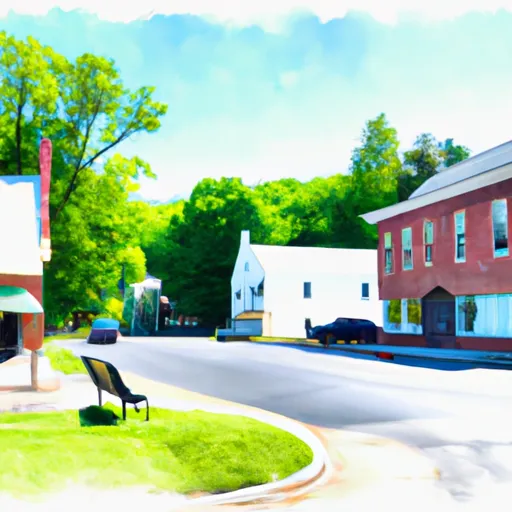-
 Snoflo Premium
Snoflo Premium
Get unlimited access to all our content
With no Ad interruptions! - Start Your Free Trial Login with existing account
Manns-Choice
Eden Index
Climate
8.0
•
Recreation
3.1
•
Community
•
Safeguard
4.3/10

Manns Choice, Pennsylvania is a small borough located in Bedford County, nestled within the beautiful Allegheny Mountains. The climate in Manns Choice is characterized by warm summers and cold winters, typical of the temperate continental climate found in the region. Summers are mild with temperatures ranging from the upper 70s to low 80s°F, while winters can be cold with temperatures dropping to the 20s and occasional snowfall.
Hydrologically, Manns Choice benefits from several small creeks that flow through the area, including Brush Creek and Dunnings Creek, which contribute to the hydrological network of the region. These waterways provide opportunities for fishing, kayaking, and other water-based activities.
Outdoor recreation enthusiasts will find plenty of opportunities in Manns Choice. The borough is surrounded by vast woodlands and offers numerous hiking trails, such as the historic Old Loggers Path and Mid State Trail, allowing visitors to explore the scenic beauty of the area. Additionally, nearby Blue Knob State Park offers opportunities for camping, picnicking, and skiing during the winter months.
Overall, Manns Choice, Pennsylvania offers a picturesque setting with a diverse climate, abundant water resources, and various outdoor recreation opportunities for nature enthusiasts.
What is the Eden Index?
The Snoflo Eden Index serves as a comprehensive rating system for regions, evaluating their desirability through a holistic assessment of climate health, outdoor recreation opportunities, and natural disaster risk, acknowledging the profound impact of these factors on livability and well-being.
Climate Health Indicator (CHI): 8.0
Manns-Choice receives approximately
979mm of rain per year,
with humidity levels near 83%
and air temperatures averaging around
10°C.
Manns-Choice has a plant hardyness factor of
6, meaning
plants and agriculture in this region thrive during a short period during spring and early summer. Most
plants will die off during the colder winter months.
By considering the ideal temperature range, reliable water supplies, clean air, and stable seasonal rain or snowpacks, the Climate Health Indicator (CHI) underscores the significance of a healthy climate as the foundation for quality living.
A healthy climate is paramount for ensuring a high quality of life and livability in a region, fostering both physical well-being and environmental harmony. This can be characterized by ideal temperatures, reliable access to water supplies, clean air, and consistent seasonal rain or snowpacks.
Weather Forecast
Streamflow Conditions
Lower Susquehanna
Area Rivers
Lower Susquehanna
Snowpack Depths
Lower Susquehanna
Reservoir Storage Capacity
Lower Susquehanna
Groundwater Levels
Recreational Opportunity Index (ROI): 3.1
The Recreational Opportunity Index (ROI) recognizes the value of outdoor recreational options, such as parks, hiking trails, camping sites, and fishing spots, while acknowledging that climate plays a pivotal role in ensuring the comfort and consistency of these experiences.
Access to outdoor recreational opportunities, encompassing activities such as parks, hiking, camping, and fishing, is crucial for overall well-being, and the climate plays a pivotal role in enabling and enhancing these experiences, ensuring that individuals can engage in nature-based activities comfortably and consistently.
Camping Areas
| Campground | Campsites | Reservations | Toilets | Showers | Elevation |
|---|---|---|---|---|---|
| Wolf Gap | 10 | 2,245 ft | |||
| Spring Gap - C and O Canal National Park | 19 | 563 ft | |||
| Green Ridge State Forest Dispersed | 100 | 1,076 ft | |||
| Trout Pond | 70 | 1,995 ft | |||
| Hawk | 15 | 1,381 ft | |||
| Adams Croyle | None | 1,688 ft | |||
| Shawnee State Park | None | 1,254 ft | |||
| Short Mountain WMA | 74 | 2,136 ft | |||
| Rocky Gap State Park | 278 | 1,231 ft | |||
| Blue Knob State Park | None | 2,576 ft |
Nearby Ski Areas
Catastrophe Safeguard Index (CSI):
The Catastrophe Safeguard Index (CSI) recognizes that natural disaster risk, encompassing floods, fires, hurricanes, and tornadoes, can drastically affect safety and the overall appeal of an area.
The level of natural disaster risk in a region significantly affects safety and the overall livability, with climate change amplifying these risks by potentially increasing the frequency and intensity of events like floods, fires, hurricanes, and tornadoes, thereby posing substantial challenges to community resilience and well-being.
Community Resilience Indicator (CRI):
The Community Resilience Indicator (CRI) recognizes that education, healthcare, and socioeconomics are crucial to the well-being of a region. The CRI acknowledges the profound impact of these elements on residents' overall quality of life. By evaluating educational resources, healthcare accessibility, and economic inclusivity, the index captures the essential aspects that contribute to a thriving community, fostering resident satisfaction, equity, and social cohesion.

